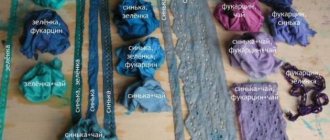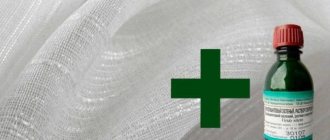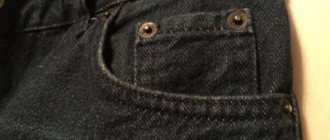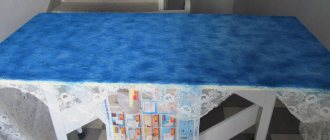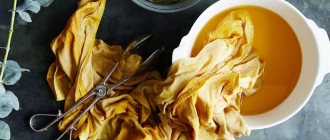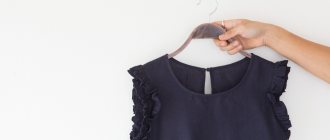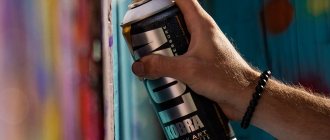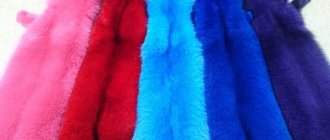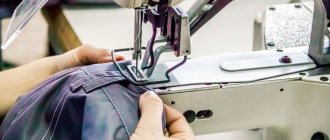We have all at least once encountered the need to dye clothes at home. And, if some things cannot be transformed without resorting to the help of professional dry cleaners, then others can be dyed at home, obtaining an excellent result. The type of fabric, the composition of the paint, the complexity of the work algorithm - these are three factors that you should pay attention to when starting to color your clothes yourself.
Why painting is needed
Coloring with permanent dyes may be necessary for various reasons. If an item is outdated and has lost its color after repeated washings, but you don’t want to part with it, tinting with dye can give it a second life, significantly extending its service life. Using paint, you can hide stubborn stains on your favorite clothes, make them a shade darker, for a better combination with the rest of your wardrobe.
Fabrics yellowed from bleaching will literally sparkle with new colors if you color them with special compounds. Many people dye textiles not only for utilitarian reasons. Using clothing dyes, you can create a unique designer item in the style of boho, tie-dye, batik, as well as color yarn and scraps for projects using knitting and patchwork techniques.
At the preparatory stage, it is important to remember that different dyes are needed for different purposes and types of fabric, since the dyeing results directly depend on the compatibility of the fabric base, the dye composition and the dyeing technology.
Color fading is one of the reasons for dyeing clothes.
Determining the naturalness of fabric
The naturalness of the fabric is the most important point. For example, a cotton T-shirt, tulle or linen pants will be easier to dye than synthetic fibers such as polyester blends or bolognese items. If, for example, your jacket or parka is made of 100% polyester, then you will have a lot of trouble updating the color. And if the composition of the synthetic fabric is mixed, then prepare for the fact that the final color may turn out to be somewhat paler than intended.
Dye runs off synthetic and artificial fibers like water from plastic bags. You should also be very careful with the fur. After dyeing with chemical dyes, your favorite woolen sweater can deteriorate and lose its former appearance. Wool fibers may become more brittle and stiff.
Types of Dyes
The composition of the fabric and the purpose of the dyeing procedure will determine what type of dye will need to be used. In art and sewing stores you can purchase paint in the form of:
- powder;
- fabric markers;
- spray;
- coloring paste mass.
If you need to update the color or evenly tint the item, you should opt for powdered aniline dyes. They can be used in the washing machine, or you can dye the product by hand. If they are solving a more complex artistic problem, choose acrylic paints in any suitable release form.
It should be remembered that the chemical composition of dyes is quite different and is not suitable for all types of clothing. More details about this are written in the instructions, which you should definitely read. How to dye clothes and what paint to choose? This is interesting: dyeing a down jacket.
Acrylic paints
Acrylic dyes cotton, natural silk, and wool well. It is better to check the possibility of dyeing synthetics in the instructions. This type of paint contains pigments that are harmless to humans, acrylic binders and water. The presence of the last component allows you to dilute the paint with water to obtain lighter shades. When choosing acrylic paint, you should pay attention to the markings. Only compositions marked “For fabric” are suitable for dyeing clothes. You can paint things with acrylic without this mark, but then the result of the work will be unpredictable.
Pay attention to: Methods for dyeing clothes at home
Acrylic, when working with it, is easily washed off with water, but after drying it is firmly embedded in the fabric. Finished products are perfectly resistant to machine washing at 40 degrees, as well as hand washing in a basin, but the first few times it is better to wash the dyed clothes separately from other items. This dye is perfect for tie-dai and batik techniques and for making complex patterns on clothes, as it spreads moderately over the fabric during application.
Acrylic paint for fabrics
Aniline dyes
These paints are used for all types of natural fabrics, leather, as well as for mixed textiles, which contain more than 50% natural fibers. Recently, aniline pigments for synthetics have appeared on the market. The possibility of coloring artificial materials is indicated in the instructions. The dyes have an organic composition; dyed products do not have a toxic effect on the owner’s skin. The paints are sensitive to the sun and aggressive washing at high temperatures, but with proper care of the product they will delight the eye with bright colors for more than one season.
Aniline dyes are widely used in the textile industry. For home use, powder and liquid forms of the dye are available, which are then diluted in water. In order for the paint to adhere to clothing, the item is boiled in a dye solution, then dried, steamed and washed several times to remove any remaining pigment. This pigment can be used to dye clothes in the washing machine.
Aniline dye for fabrics
Natural paints
This type of dye is suitable for all types of natural textiles, however, dyeing results are difficult to predict, so it is recommended to test the composition on a small area of fabric. Natural pigments are less resistant to washing powder and sunlight, but are less likely to cause allergic reactions. How can you dye clothes? The following colors are obtained naturally:
- red - from beets, blueberries, ripe elderberries;
- yellow - from wormwood branches, orange peel, ground turmeric;
- ocher - from celandine juice;
- brown - from tea, coffee, henna, onion peels and oak bark;
- blue - from blackberries, a mixture of spinach and curcumin;
- green - spinach, elderberries;
- gray - from bearberry, broom.
Clothes are tinted in the prepared broth, the temperature of which is maintained at around 60 degrees. After some time, the paint is fixed with special substances (ferroammonium and potassium alum, copper sulfate, etc.), then rinsed and dried. Dyeing clothes with natural compounds is a very labor-intensive, but very exciting process, which is suitable for creating plain clothes in boho and folk styles.
Natural dyes
Choosing the color of natural dye
To give the desired color to clothes, dyeing ingredients can be found in the kitchen.
- Black color. This can be achieved using natural coffee.
- Blue color. Achieved by using blackberries, red cabbage, and sage.
- Red color. Produced by using beets, elderberries and blueberries.
- Brown color. To obtain this color, onion peels, tea, weak coffee and tobacco are perfect.
- Green color. Excellent from spinach, juniper berries and sorrel.
- Orange and yellow color. This color is obtained if you use sea buckthorn or turmeric, carrots, or orange peel.
Important! To fix the color you need to use vinegar and salt.
Features of coloring different materials
Here are some general guidelines for coloring clothes made from different fabrics.
Cotton products are dyed in water with a low calcium content (the so-called “soft water”), and after tinting they are rinsed in a weak solution of vinegar (1 tbsp per 5 l). As a result, the pigment will adhere more strongly to the fabric, and the item will not fade when washed.
Pay attention to: How to dye clothes, tulle with brilliant green: the process of manual dyeing or in an automatic machine, caring for the product after dyeing
When painting linen products, add a spoonful of salt to the solution, so the item will be dyed better and more evenly. Woolen items are evenly colored with an aniline dye with a special mark. Acrylic for wool is used much less frequently - it does not dye well and spoils the structure of the fabric.
Silk clothes must be washed and rinsed before tinting in order to remove the impregnating composition from the new item and the remains of household chemicals from the old one. Clothes made of tulle are difficult to color. For better adhesion of the pigment to the fibers, it is recommended to starch the item. Viscose and polyester are not dyed with natural dyes.
Dyeing of other types of fabrics
- Tulle. Painted with brilliant green, blue or potassium permanganate. Any natural dye will also work.
- Knitwear. Any color option is suitable for this type of fabric. The main condition is that the water for dyeing should not be very hot so that the knitwear does not become deformed.
- Lace. Can also be painted in any way. Only the exposure time in the solution should not exceed 20 minutes.
- Rubberized fabric. Mix construction color with rubber glue. Apply the mixture with a brush to the product. Leave until completely dry.
- Sintepon. For painting such material, a can of auto enamel in the form of a spray is well suited.
The process of dyeing clothes at home is not easy. It is necessary to select a dye according to the type of fabric. Make sure to use dyes in the right proportions and ensure that the product is kept in the dye for a period of time.
It is better to dry-clean synthetic and delicate fabrics. A freshly dyed item should be washed at first separately from the rest of the laundry.
To wash dyed fabrics, you need to use colored laundry detergent. Items should be dried away from sunlight to avoid color fading.
Necessary tool
To dye clothes at home you will need:
- dye;
- a simple pencil (if a design is planned on the fabric, its outline is drawn);
- brushes or syringes without needles;
- a piece of clean cloth;
- palette for mixing colors;
- cotton pads (sticks);
- containers for coloring (old pots, basins);
- water or other paint thinner.
The specific set of tools is determined by the nature of the pattern and the chosen coloring technology.
Simple pencils
Syringe without needle
Cotton pads
Preparatory work
The preparatory stage involves soaking the clothing (the base to be dyed) in cold water for an hour. After soaking, the base is hand washed and rinsed. Dyeing is done on dry fabric, so the clothes must be thoroughly dried. The dried fabric is ironed with an iron set to medium temperature. If the clothes are made of thin fabric, you can stretch them on a wooden frame to dry. When hand painting, you need to place a slightly absorbent base (for example, cardboard, thick paper) or a non-absorbent base (a piece of film) under the fabric to be painted.
Soaking clothes in cold water
Dyeing process
Now directly about how to dye clothes. Different types of dyes require different algorithms of action.
Aniline dyes
Read the instructions on the package carefully. Wear rubber gloves. Dilute the dye in a saucepan with water according to the instructions. Please note that after the staining procedure, you will no longer be able to use the pan for cooking. Then, for uniform coloring, lower the item into the solution, place the pan on the fire and boil the contents for the specified number of minutes. Make sure that all parts of the clothing are below the level of the solution, otherwise the item will be dyed unevenly.
Allow the contents to cool and carefully remove the clothing from the solution, rinse, and dry. If you plan to use gradient toning, repeat the previous steps, this time omitting the part of the clothing that is intended to be darker. Afterwards, the dry item needs to be steamed so that the dye is fixed. You can steam it over a pan, steamer, or a regular iron with a steam function. Next, the painted product is washed several times to remove any remaining pigment.
Dyeing in a washing machine is carried out strictly in accordance with the instructions on the packaging. Please note that aniline dyes will not allow you to apply a design with clear contours. For work using the batik technique, a special contour is used, which is purchased separately. At the same time, the fabric is stretched on a hoop, paints are applied using brushes, and the cooking stage is skipped, going straight to multiple steaming.
Dyeing with aniline dye
Acrylic paints
Read the instructions and wear rubber gloves. For monochromatic coloring, dilute the acrylic container with water in the required proportion (the more water, the paler the color will be). Place the fabric product in a basin with an acrylic solution, soak for the recommended amount of time, remove and dry completely. Rinse the item in cold water, dry and iron. Wash several times as usual.
Please note: Paint plastic pipes
To create clothes in the tie-dai style, before dyeing, things need to be twisted and knitted in a random order. For example, for a spiral pattern, you can twist the fabric in a spiral by wrapping it around a fork. To get abstract streaks and bubbles, tie things in a knot, or create knots and folds using rubber bands/ropes. Dip the knitted item one at a time into acrylic solutions, being careful not to mix colors.
Syringes without needles are suitable for applying paint: take different colors into different five-cc syringes and spray directly onto the fabric. Let the paint dry completely. This may take more than one day. Once the paint has dried, the product can be untied. The straightened clothes are rinsed in cold water, dried and ironed.
Painting with acrylic paint
Natural paints
Prepare a decoction from the selected ingredient. This can be tea, coffee, henna for hair, celandine juice, blueberries, blackberries, elderberries and other plants. The broth cannot be boiled. Place clothing in the resulting liquid dye and boil it for 40-60 minutes (the temperature should not exceed 60 degrees). Let the broth cool and remove the clothes from it. Dip the garment into the fixer using a clothes tong.
Be careful as the fixative is very poisonous.
Leave the cloth for 15-20 minutes. Take the item out and rinse it well in cold water and iron it.
Coloring with natural dyes
Technology of the process of preparing dye and fabric at home
The whole technology is extremely simple and will be understandable even for beginners. After determining the desired color, you need to cut the selected ingredient and put it in the pan. You will need twice as much water. For pale saturation, it is enough to leave the resulting composition to cool for one hour. For a more intense color, leave overnight. After cooling, the liquid must be strained.
The fabric needs pre-treatment. Before dyeing a product, you need to know that fabrics made from natural materials are much easier to dye than synthetics.
- Clean the product from stains and dirt. You can use a stain remover.
- Boil things in an enamel container with the addition of soda. One liter of water will require 0.5-0.7 grams of soda. To mix clothes, you need to use a wooden stick.
- Remove buttons, fasteners and decorations from clothing.
